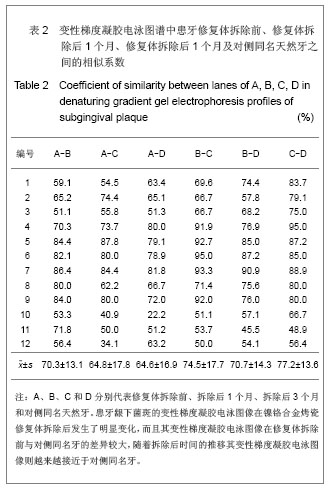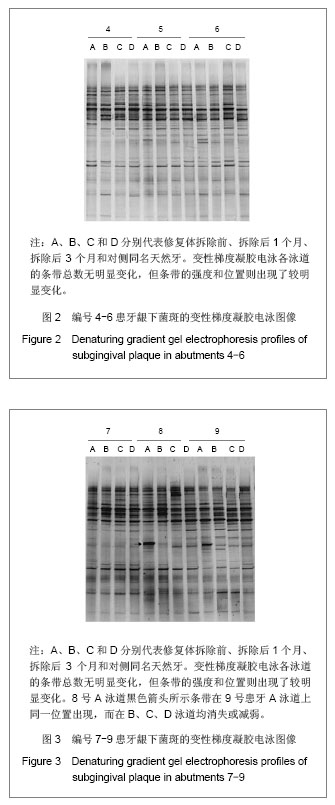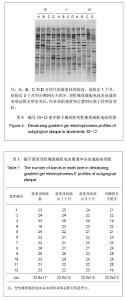Chinese Journal of Tissue Engineering Research ›› 2013, Vol. 17 ›› Issue (51): 8834-8840.doi: 10.3969/j.issn.2095-4344.2013.51.009
Previous Articles Next Articles
Variation in subgingival flora of abutments before and after removal of nickel-chromium alloy porcelain-fused-to-metal restoration
Guo Da-wei1, Song Ling1, Zhang Chun-yan1, Cao Yang1, Li Jing-wen2, Liang Xing2
- 1 Department of Stomatology, Qingdao Municipal Hospital, Qingdao 266071, Shandong Province, China; 2 Department of Prosthodontics, West China Hospital of Stomatology, Sichuan University, Chengdu 610041, Sichuan Province, China
-
Online:2013-12-17Published:2013-12-17 -
Contact:Liang Xing, Chief physician, Professor, Doctoral supervisor, Department of Prosthodontics, West China Hospital of Stomatology, Sichuan University, Chengdu 610041, Sichuan Province, China xingliangdent@vip.163.com -
About author:Guo Da-wei,☆ M.D., Attending physician, Associate professor, Master’s supervisor, Department of Stomatology, Qingdao Municipal Hospital, Qingdao 266071, Shandong Province, China dawei_guo@163.com -
Supported by:the Basic Research Program of Qingdao Scientific Plan, No. 12-1-4-16-(8)-jch*; the Health Scientific Plan of Qingdao City, No. 2012-WSZD005*; Dean’s Specific Fund of Qingdao Municipal Hospital, No. ZYZJJ-2013- W020-pei*
CLC Number:
Cite this article
Guo Da-wei, Song Ling, Zhang Chun-yan, Cao Yang, Li Jing-wen, Liang Xing. Variation in subgingival flora of abutments before and after removal of nickel-chromium alloy porcelain-fused-to-metal restoration[J]. Chinese Journal of Tissue Engineering Research, 2013, 17(51): 8834-8840.
share this article

2.3 变性梯度凝胶中特异性16S rDNA片段的基因序列分析 虽然各组患牙龈下菌斑的变性梯度凝胶电泳图像在拆除原镍铬合金烤瓷修复体后出现的变化也各不相同,但有一些变化则是在多组出现且变化较明显。实验选择了在2,3,4号患牙的A泳道上均在同一位置出现,而在B、C、D泳道消失或减弱的条带,以及在5,6,8、9号患牙A泳道上均在同一位置明显出现,而在B、C、D泳道消失或减弱的条带作分析,分别选择其中2号A泳道上的条带(见图1黑色箭头所示)和位于8号A泳道的强度较高的那条条带(见图3黑色箭头所示)作切胶、克隆、16S rDNA片段的基因序列分析。分析结果显示,2号A泳道上的条带的16S rDNA基因序列与啮蚀艾肯菌的基因序列相似度为98%,8号A泳道条带的基因序列与直形弯曲菌基因序列相似度为96%。此外,本实验还对1号患牙A泳道上出现的一条带(见图1黑色箭头所示)进行了切胶、基因序列分析,该条带在1号患牙B、C、D泳道上均明显减弱,而且在其它患牙的变性梯度凝胶电泳图像上也基本没有出现或较弱,分析结果显示,该条带的基因序列与隐藏优杆菌有98%的基因序列相似度。"

| [1]刘梦桃,贾安琦.镍铬合金烤瓷修复体对局部牙龋组织损伤的机制[J].国外医学:口腔医学分册,2004,31(1): 44-45.[2]张荣和,宋琦,张勇.镍铬合金烤瓷冠组织面离子析出的研究[J].国际口腔医学杂志, 2008,35(6):611-614.[3]Imirzalioglu P,Alaaddinoglu E,Yilmaz Z,et al.Influence of recasting different types of dental alloys on gingival fibroblast cytotoxicity. J Prosthet Dent.2012;107(1):24-33.[4]Muyzer G,de Waal EC,Uitterlinden AG.Profiling of complex microbial populations by denaturing gradient gel electrophoresis analysis of polymerase chain reaction-amplified genes coding for 16S rRNA.Appl Environ Microbiol.1993;59(3):695-700.[5]Su C,Lei L,Duan Y,et al.Culture-independent methods for studying environmental microorganisms: methods, application, and perspective.Appl Microbiol Biotechnol.2012;93(3): 993-1003.[6]Mikesková H,Novotný C,Svobodová K.Interspecific interactions in mixed microbial cultures in a biodegradation perspective. Appl Microbiol Biotechnol.2012;95(4):861-870.[7]Cocolin L,Dolci P,Rantsiou K.Biodiversity and dynamics of meat fermentations: the contribution of molecular methods for a better comprehension of a complex ecosystem.Meat Sci. 2011;89(3):296-302.[8]Zheng L,Gao N,Deng Y.Evaluation of DNA extraction methods for the analysis of microbial community in biological activated carbon. Environ Technol.2012; 33(4-6):437-444.[9]Minas K,McEwan NR,Newbold CJ,et al.Optimization of a high-throughput CTAB-based protocol for the extraction of qPCR-grade DNAfrom rumen fluid, plant and bacterial pure cultures.FEMS Microbiol Lett.2011;325(2):162-169.[10]Gillan DC,Speksnijder AG,Zwart G,et al.Genetic diversity of the biofilm covering Montacuta ferruginosa (Mollusca, bivalvia) as evaluated by denaturing gradient gel electrophoresis analysis and cloning of PCR-amplified gene fragments coding for 16S rRNA.Appl Environ Microbiol. 1998;64(9):3464-3472.[11]Zijnge V,Harmsen HJ,Kleinfelder JW,et al.Denaturing gradient gel electrophoresis analysis to study bacterial community structure in pockets of periodontitis patients.Oral Microbiol Immunol.2003;18(1):59-65.[12]Bulgari D,Casati P,Brusetti L,et al.Endophytic bacterial diversity in grapevine (Vitis vinifera L.) leaves described by 16S rRNA gene sequence analysis and length heterogeneity- PCR.J Microbiol.2009;47(4):393-401.[13]Neonakis IK,Gitti Z,Kontos F,et al.Mycobacterium arupense pulmonary infection: antibiotic resistance and restriction fragment length polymorphism analysis.Indian J Med Microbiol. 2010;28(2):173-176.[14]Ong SH,Kukkillaya VU,Wilm A,et al.Species Identification and Profiling of Complex Microbial Communities Using Shotgun Illumina Sequencing of 16S rRNA Amplicon Sequences.PLoS One.2013;8(4):e60811.[15]Rudi K,Sekelja M.High or low correlation between co-occuring gene clusters and 16S rRNA gene phylogeny.FEMS Microbiol Lett.2013;339(1):23-29.[16]Wulff NA,Eveillard S,Foissac X,et al.rRNA operons and genome size of 'Candidatus Liberibacter americanus', a bacterium associated with citrus huanglongbing in Brazil.Int J Syst Evol Microbiol.2009;59(8):1984-1991.[17]Caselli M,Cassol F,Gentili V,et al.Genome sequences of segmented filamentous bacteria in animals: implications for human research.Gut Microbes.2012;3(5):401-405. [18]Korobeinikova AV,Garber MB,Gongadze GM.Ribosomal proteins: structure, function, and evolution. Biochemistry (Mosc).2012;77(6):562-574. [19]Schrenzel MD,Witte CL,Bahl J,et al.Genetic characterization and epidemiology of Helicobacters in non-domestic animals. Helicobacter.2010; 15(2):126-142.[20]Silva CC,Jesus EC,Torres AP,et al.Investigation of bacterial diversity in membrane bioreactor and conventional activated sludge processes from petroleum refineries using phylogenetic and statistical approaches.J Microbiol Biotechnol. 2010;20(3):447-459.[21]Wieland M,Berschneider B,Erlacher MD,et al. Aptazyme-mediated regulation of 16S ribosomal RNA. Chem Biol.2010;17(3):236-242.[22]Větrovský T,Baldrian P.The variability of the 16S rRNA gene in bacterial genomes and its consequences for bacterial community analyses.PLoS One. 2013;8(2):e57923.[23]Fischer SG,Lerman LS.Length-independent separation of DNA restriction fragments in two-dimensional gel electrophoresis.Cell.1979; 16(1):191-200. [24]周彦玢,束蓉,刘大力.应用变性梯度凝胶电泳分析牙周基础治疗前后龈下菌群的变化[J].上海口腔医学,2012,21(1):73-78.[25]刘彩霞,胡燕,周东蕊,等.聚合酶链反应-变性梯度凝胶电泳技术动态分析不同分娩方式对新生儿早期肠道菌群的影响[J].实用儿科临床杂志,2012, 27(19):1491-1494.[26]孟庆伟,赵尔扬.牙周炎致病菌的变性梯度凝胶电泳检测[J].国际口腔医学杂志, 2009,36(5): 547-549.[27]Sato K,Azama Y,Nogawa M,et al.Analysis of a change in bacterial community in different environments with addition of chitin or chitosan.J Biosci Bioeng. 2010;109(5): 472-478. [28]江泳,陈智滨,冯海兰.镍铬合金烤瓷冠修复上颌切牙对牙周组织的影响[J].口腔医学,2004,24(5): 279-280.[29]赵彤,高平.镍铬合金烤瓷冠对龈沟液中IL-1β及AST水平的影响[J].口腔颌面修复学杂志,2007,8(3): 172-174.[30]Li RQ,Kan HX,Zheng ZF.Effects of Ni-Cr based porcelain-fused-to-metal crown on periodontal tissue. J Clin Rehabil Tissue Eng Res.2009;13(25):4989-4992. [31]Ozen J,Atay A,Beydemir B,et al.In vitro IL-1beta release from gingival fibroblasts in response to pure metals, dental alloys and ceramic.J Oral Rehabil.2005;32(7):511-517.[32]Barnes VM,Teles R,Trivedi HM,et al.Acceleration of purine degradation by periodontal diseases.J Dent Res.2009; 88(9): 851-855.[33]Darany DG,Beck FM,Walters JD.The relationship of gingival fluid leukocyte elastase activity to gingival fluid flow rate.J Periodontol.1992; 63(9):743-747.[34]Haffajee AD,Yaskell T,Torresyap G,et al.Comparison between polymerase chain reaction-based and checkerboard DNA hybridization techniques for microbial assessment of subgingival plaque samples.J Clin Periodontol.2009; 36(8): 642-649.[35]Surna A,Kubilius R,Sakalauskiene J,et al.Lysozyme and microbiota in relation to gingivitis and periodontitis.Med Sci Monit.2009;15(2):66-73.[36]D'Ercole S,Catamo G,Tripodi D,et al.Comparison of culture methods and multiplex PCR for the detection of periodontopathogenic bacteria in biofilm associated with severe forms of periodontitis.New Microbiol.2008; 31(3): 383-391.[37]Miyagawa J,Maeda H,Murauchi T,et al.Rapid and simple detection of eight major periodontal pathogens by the loop-mediated isothermal amplification method. FEMS Immunol Med Microbiol 2008;53(3):314-321.[38]Fujimoto C,Maeda H,Kokeguchi S,et al.Application of denaturing gradient gel electrophoresis (DGGE) to the analysis of microbial communities of subgingival plaque.J Periodontal Res.2003;38(4):440-445.[39]Zijnge V,Harmsen HJ,Kleinfelder JW,et al.Denaturing gradient gel electrophoresis analysis to study bacterial community structure in pockets of periodontitis patients.Oral Microbiol Immunol.2003;18(1):59-65.[40]郭大伟,滕敏华,陈正岗,等.镍铬合金烤瓷修复体拆除前后患者血清镍铬含量的检测与评估[J].中国组织工程研究,2012,16(34): 6457-6460. |
| [1] | Xu Nuo, Cao Zhen, Li Xiaojie, Shi Chun. MicroRNA-21 regulates proliferation and differentiation of osteoclasts in periodontitis [J]. Chinese Journal of Tissue Engineering Research, 2020, 24(8): 1225-1230. |
| [2] | Wu Dalei, Zhou Shouheng, Yan Jianwei, Li Bo, Xu Nuo, Shi Chun, Gao Yang. Alcohol extract of Eucommia ulmoides Oliv. promotes bone healing in rats with periapical periodontitis [J]. Chinese Journal of Tissue Engineering Research, 2020, 24(23): 3685-3689. |
| [3] | Wu Hui, Xu Nuo, Wang Qian, Shi Chun, Jiang Long. Screening chronic periodontitis-related genes using whole-genome expression profiling [J]. Chinese Journal of Tissue Engineering Research, 2020, 24(23): 3615-3620. |
| [4] |
Zhang Yujing, Peng Yuzhi, Liu Baozhen, Jing Fang.
Effect of Xianling Gubao Capsule
on alveolar bone mass in postmenopausal women with periodontitis: a cone-beam
CT evaluation
|
| [5] | Xu Huijun, Shi Dongmei, Zhang Mi, Wu Saixuan, Dong Ming, Lu Ying, Niu Weidong. Effect of sex combing protein 1 on proliferation and differentiation of osteoblasts in inflammatory microenvironment#br# [J]. Chinese Journal of Tissue Engineering Research, 2020, 24(1): 130-135. |
| [6] | Yang Chunhe, Zhang Hong, Dong Ming, Wang Lina, Niu Weidong. Expression of PLCgamma2 in a wild-type mouse model of chronic periapical periodontitis [J]. Chinese Journal of Tissue Engineering Research, 2019, 23(7): 1057-1062. |
| [7] | Zuo Meina1, Wang Lina1, Han Shujuan2, Dong Ming3, Niu Weidong1. Expression of myeloid differentiation factor 88 in a rat model of experimental periapical periodontitis [J]. Chinese Journal of Tissue Engineering Research, 2019, 23(7): 1068-1072. |
| [8] | Chen Xi, Shi Qiaorui, Zheng Ming, Cheng Hui. Corrosion resistance of gold-platinum ceramic alloys after repeated casting [J]. Chinese Journal of Tissue Engineering Research, 2019, 23(6): 838-842. |
| [9] | Chen Run, Qiu Bingyan, Jiang Lei, Pan Yu, Wang Yinghui, Cheng Hui. Effect of dental ceramic alloys on the expression of apoptosis-related signal proteins in the oral buccal mucosa of golden hamsters [J]. Chinese Journal of Tissue Engineering Research, 2019, 23(6): 883-887. |
| [10] | Zhao Xiangyu, Zhang Guirong, Guo Chuanbo, Shi Chun, Wu Liuzhong. Increased expression of long-chain non-coding RNA LINC00511 in periodontitis promotes osteoclast proliferation [J]. Chinese Journal of Tissue Engineering Research, 2019, 23(33): 5360-5365. |
| [11] | Zhang Hong, Ye Dandan, Dong Ming, Niu Weidong. Expression of RANKL in chronic periapical periodontitis in mice [J]. Chinese Journal of Tissue Engineering Research, 2019, 23(3): 391-395. |
| [12] | Yang Na1, Bao Pingping2, Lei Tao2. Adiponectin levels in plasma and periodontal tissue of mouse models of diabetic periodontitis treated by adiponectin [J]. Chinese Journal of Tissue Engineering Research, 2019, 23(23): 3692-3697. |
| [13] | Du Shasha, Cai Zhiguo, Yang Kun, Liu Qi. Dental-derived mesenchymal stem cells promote periodontal tissue regeneration: possibility and prospects [J]. Chinese Journal of Tissue Engineering Research, 2019, 23(17): 2782-2788. |
| [14] | Ma Jinbao1, Wang Qian2, Dong Ming3, Bai Hua2. Expression of autophagy-associated protein light chain 3B in human pulpitis and periapical periodontitis [J]. Chinese Journal of Tissue Engineering Research, 2019, 23(15): 2364-2368. |
| [15] | Wu Hui1, Jiang Long2, Li Xiaojie3, Ji Qiushi2, Xu Nuo2. Effect of paclitaxel on proliferation and differentiation of osteoclasts in periapical periodontitis [J]. Chinese Journal of Tissue Engineering Research, 2019, 23(11): 1647-1651. |
| Viewed | ||||||
|
Full text |
|
|||||
|
Abstract |
|
|||||





